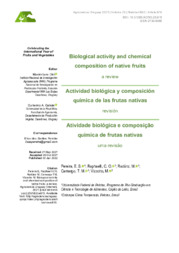Biological activity and chemical composition of native fruits.
Biological activity and chemical composition of native fruits.
Author(s): PEREIRA, E. S.; RAPHAELLI, C. O.; RADÜNZ, M.; CAMARGO, T. M.; VIZZOTTO, M.
Summary: Brazilian native fruit trees have great potential for their use in the food and pharmaceutical industries. Among these, the Myrtaceae family stand out for the diversity of known native fruits, as the case of ?araçazeiro? or cattley guava [Psidium cattleianum], ?pitangueira?, Suriname cherry or Brazilian cherry [Eugenia uniflora], ?gua-bijuzeiro? [Myrcianthes pungens], ?guabirobeira? [Campomanesia xanthocarpa] and ?uvalheira? [Eugenia pyri-formis]. These fruits contain substances of nutritional and potentially functional importance, including dietary fiber, vitamins (especially A and C) and minerals (potassium, iron, manganese, magnesium, calcium, phospho-rus), as well as antioxidant compounds, such as phenolics and carotenoids. The consumption of fruits rich in bioactive compounds and high antioxidant activity has the potential to prevent chronic non-communicable dis-eases such as cancer, diabetes mellitus, dyslipidemias, cardiovascular diseases, and chronic respiratory dis-eases. For example, Suriname cherry and cattley guava fruit extracts showed anti-hyperglycemic, anti-dyslipidemic and antioxidant effects in animal models with insulin resistance, cattley guava also showed anticar-cinogenic, antimicrobial, anti-inflammatory and anti-aging activities. ?Uvaia? has a promising effect as an antimi-crobial agent. In this review, summarized information on the main native fruits of the Myrtaceae is presented, highlighting their composition and biological activities in order to direct new research.
Publication year: 2021
Types of publication: Journal article
Keywords: Fruta, Fruta nativa, Myrtaceae, Pesquisa, Saúde
Observation
Some of Embrapa's publications are published as ePub files. To read them, use or download one of the following free software options to your computer or mobile device. Android: Google Play Books; IOS: iBooks; Windows and Linux: Calibre.
Access other publications
Access the Agricultural Research Database (BDPA) to consult Embrapa's full library collection and records.
Visit Embrapa Bookstore to purchase books and other publications sold by Embrapa.

